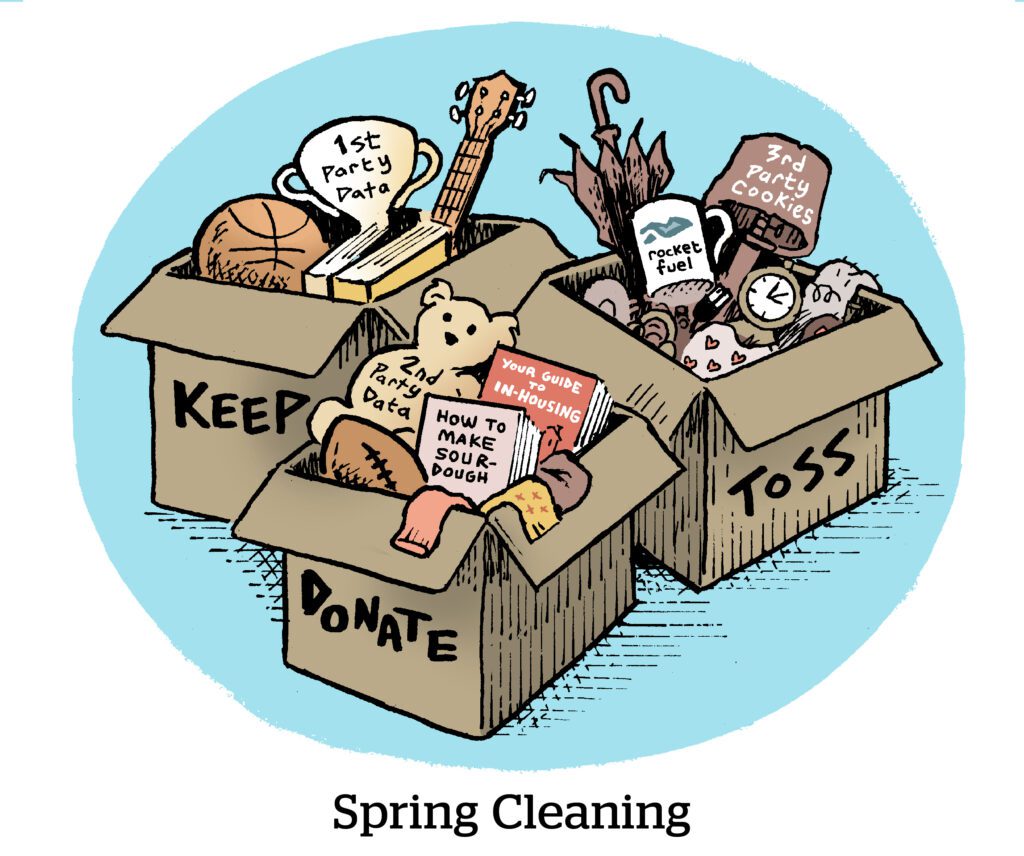Losing third-party cookies is often framed as a negative for the advertising industry. But it doesn’t have to be, according to The Trade Desk (TTD).
“Cookie deprecation is going to drive better data, better personalization,” said Ben Sylvan, VP of data partnerships at TTD, during a session on retail data at Night Market’s eCommFronts event in New York City last week. “It’s going to lead to a much cleaner and more sustainable internet.”
The session was moderated by Olivia Giaimo, group director of ecommerce media sciences at the Horizon Media agency Night Market.
Sylvan said programmatic advertising is shifting away from behavioral data, which tracks the online content people consume and engage with via anonymous identifiers like cookies. Broad-based demographic targeting – “using a proxy for what people buy or what they’re going to do” – is falling out of favor as well, he said.
Stepping into the void is retail data.
“When I get a loyalty card from my local grocer, I’m giving them my email and phone number,” Sylvan said. He predicts advertisers will use hashed email addresses and phone numbers as well as new deterministic identifiers (like TTD’s Unified ID 2.0 IDs) across CTV, audio and display buys.
Stronger signals
In the past, third-party providers “inferred a lot about people based on one web visit,” Sylvan said. For instance, just because someone clicks on a piece of content about motorcycles one time doesn’t mean they’re shopping for new wheels.
Similarly, a diaper brand that historically bought ads on linear TV using basic demographic targets (think “female” or “25-35”) was “essentially playing a guessing game” about who was having babies, rather than making a confident, data-driven decision on which consumers to target, Sylvan said. The brand wasted impressions and media spend on people who would never buy diapers.
Retailers, on the other hand, don’t have to infer what people want. They have years, even decades, of purchase data that can be used to create detailed customer segments. If a diaper brand wants to reach diaper buyers from a given retailer, such as Albertsons, Kroger, Walgreens, Sam’s Club or Instacart, it can bid against a hefty audience of verified diaper purchasers and remove people who aren’t interested in diapers from the audience.
One of those verified buyers could be Sylvan, who was a sports journalist subsisting on ramen and mac and cheese who’d never buy diapers … until he became a father of three who bought diapers for more than eight consecutive years. And retailers have his transactions to prove exactly the kind of lifetime value their ads can generate.
Even nonendemic advertisers – with products that don’t sell in chain stores, like insurance or auto – can use retail purchase data to target consumers. A credit card company, for instance, might target someone for an upgraded consumer credit deal if they’ve recently begun purchasing more premium or expensive grocery items, as a signal of general consumer purchase power.
Retail data is particularly useful for financial institutions, Sylvan said, because fair lending laws mean demographic targeting is off-limits for them. (You can’t target women as “women,” but you can target Walgreens shoppers who purchase makeup and women’s shampoo.)
Hold your horses
Although retail data can fuel more targeted campaigns, there are drawbacks.
The targeting, for instance, still must be broad enough, and the audience large enough, to be worth reaching. Since the data is based on real purchases and only from customers with logged-in accounts or credit cards that share data with the retailer, it can be difficult to reach a threshold of scale, even with big retailers.
“A best practice when it comes to audiences is to think at a category level,” Sylvan said.
For instance, Hershey’s could build custom segments to target M&Ms buyers and Hershey bar buyers separately. But it’s not worth it for advertisers to zero in on every tiny niche, even if they can theoretically target “people who only buy blue M&Ms, who have dyed their hair blue with hair dye they bought at the grocery store and who also buy a lot of Diet Coke,” Sylvan said.
The advertiser’s choice
TTD has “decoupled retail media from inventory,” Sylvan said. Which means advertisers have more choices over which retailers they work with.
The DSP even has some retailers that offer the purchase data for free – if advertisers use their DSP to serve ads.
But other retailers successfully bundle data with inventory and manage where ads are served, Sylvan said. He mentioned Roundel, Target’s retail media network, as a PMP solution that TTD’s advertisers liked because of “the simplicity of [having] the inventory selected for you.”
Whatever ad platform model retailers choose for their media business, the bottom line for TTD is the ability to connect media spend to true sales. That’s why, according to Sylvan, “retail audiences are the future of data when it comes to programmatic.”














